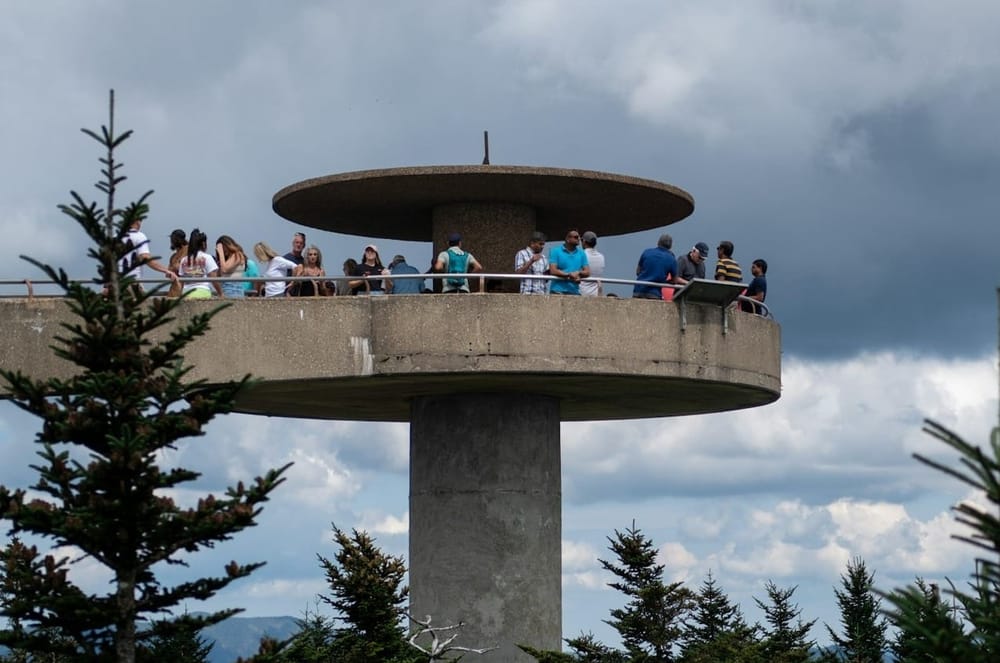Everything’s Fine in the Great Smokies! (Seriously, There's Nothing to See Here.)
We braved America’s busiest national park—before local governments and nonprofits chipped in to keep the gates open.
The Roaring Fork Motor Nature Trail forms a 5.5-mile loop through dense hardwoods, hugging the mountain slopes like a stretch of bench-cut singletrack for cars. Massive trees rise from the edge of the narrow one-lane blacktop, and waterfalls are scattered throughout the forest. It would be a transcendent cruise if it weren’t for all the minivans, safari-style Jeeps, and side-by-side ATVs clogging the road.
I was on the Roaring Fork on Labor Day weekend, one of the most visited weekends in Great Smoky Mountains National Park (GSMNP), the 500,000-acre swath of mountains and historic farmland straddling the border of North Carolina and Tennessee. GSMNP is by far the busiest national park in the country, attracting 12,191,834 visitors in 2024—almost 8 million more than the runner-up, Zion. Those visitors spent more than $2 billion last year in gateway communities like Gatlinburg, Cherokee, and Pigeon Forge.
During my visit, it seemed like most of those people were on the road ahead of me. But that’s why I was there: to see how a nationwide staff crisis was impacting America’s most popular national park.
Even before the White House furloughed 9,300 National Park Service staffers during this month’s government shutdown, this year has been a brutal one for the agency. By August, it had lost 4,055 permanent employees, nearly a quarter of its full-time staff. On October 20, the Department of the Interior revealed in court documents that it intended to abolish 2,050 more positions, including at least 272 in the park service.
But hard data from specific parks has been hard to come by. The questions I sent to Great Smoky Mountains’ acting superintendent, Charles Sellars, were politely passed on to the national communications office in Washington, D.C., which declined to comment on personnel matters. The Association of National Park Rangers, a nonprofit that works on behalf of park employees, estimated that 12 of the park’s 274 full-time employees were let go after the initial wave of layoffs in February, but the group hasn’t been able to update those numbers since.
Hard data from specific parks has been hard to come by. The questions I sent to Great Smoky Mountains’ acting superintendent, Charles Sellars, were politely passed on to the national communications office, which declined to comment on personnel matters.
“Park Service employees aren’t talking with us right now, because they’re fearful of termination,” says Bill Wade, the group’s executive director. “Information stopped flowing. They’re hunkering down and unwilling to speak about anything at all that’s going on inside the parks.”
Kristen Brengel, the senior vice presidentVP of government affairs for the National Parks Conservation Association, echoes that sentiment. “There has been a steady rate of attrition at parks across the country, but the park service is withholding all of this information from us and the media, so we can’t get firm numbers for specific parks.”
One thing we do know: Great Smoky Mountains National Park is unique because of the sheer volume of visitors. The Smokies see more people in a single month than many park units see in an entire year. Last October alone, 1.5 million people visited the park, after a million in September and another 1.5 million in August.
“Twelve million people a year is a lot of flushing toilets and a lot of feet on the trails,” says Dana Soehn, president of Friends of the Smokies, the nonprofit partner that provides operational funds for the park. “The needs and challenges are many.”
I wanted to see how the park was handling it. I live about an hour from Great Smokies, and I’ve been exploring this landscape for more than 20 years—so I know places where you’re guaranteed to see a crowd. Cades Cove Loop Road, an 11-mile loop road through a pastoral valley, is famous for its traffic jams. Two million people a year ascend to the park’s highest point, 6,643-foot Kuwohi (formerly Clingmans Dome), where a concrete lookout tower offers 360-degree views. About the same number cruise the Roaring Fork Motor Nature Trail. These are the spots I usually avoid, but on this trip, I wanted to go where the tourists were going and see what they were seeing.
I crept past a number of small trailheads, with paths that lead to waterfalls, historic cabins, and swimming holes. I’d originally planned to hike one of these trails, but every parking lot, pullout, and makeshift space along the shoulder was already packed with cars.
The park actually publishes a congestion forecasting calendar on its website to help people avoid situations like this. Each day of the year receives a rating: a green circle (not very congested, with parking likely available), a yellow triangle (moderate congestion), or—as on this Labor Day Saturday–a red diamond (“heavily congested roadways and completely full parking lots”).
Earlier in the summer, the hiring freeze had kept many campgrounds and facilities closed after their intended spring openings. According to a leaked July 2025 internal Park Service document, Great Smoky Mountains had trouble opening several campgrounds and picnic areas. The popular Abrams Creek Campground, Big Creek Campground, Cosby Campground, and Look Rock Campground were supposed to open on April 18, but didn’t open until May 19. Cades Cove is typically closed to vehicle traffic on Wednesdays from May through September, so cyclists can enjoy the road. But because of staffing issues, the first vehicle-free day didn’t come until June 18. When I visited, Collins Creek Picnic Area and Twin Creeks Picnic Pavilion were still closed.
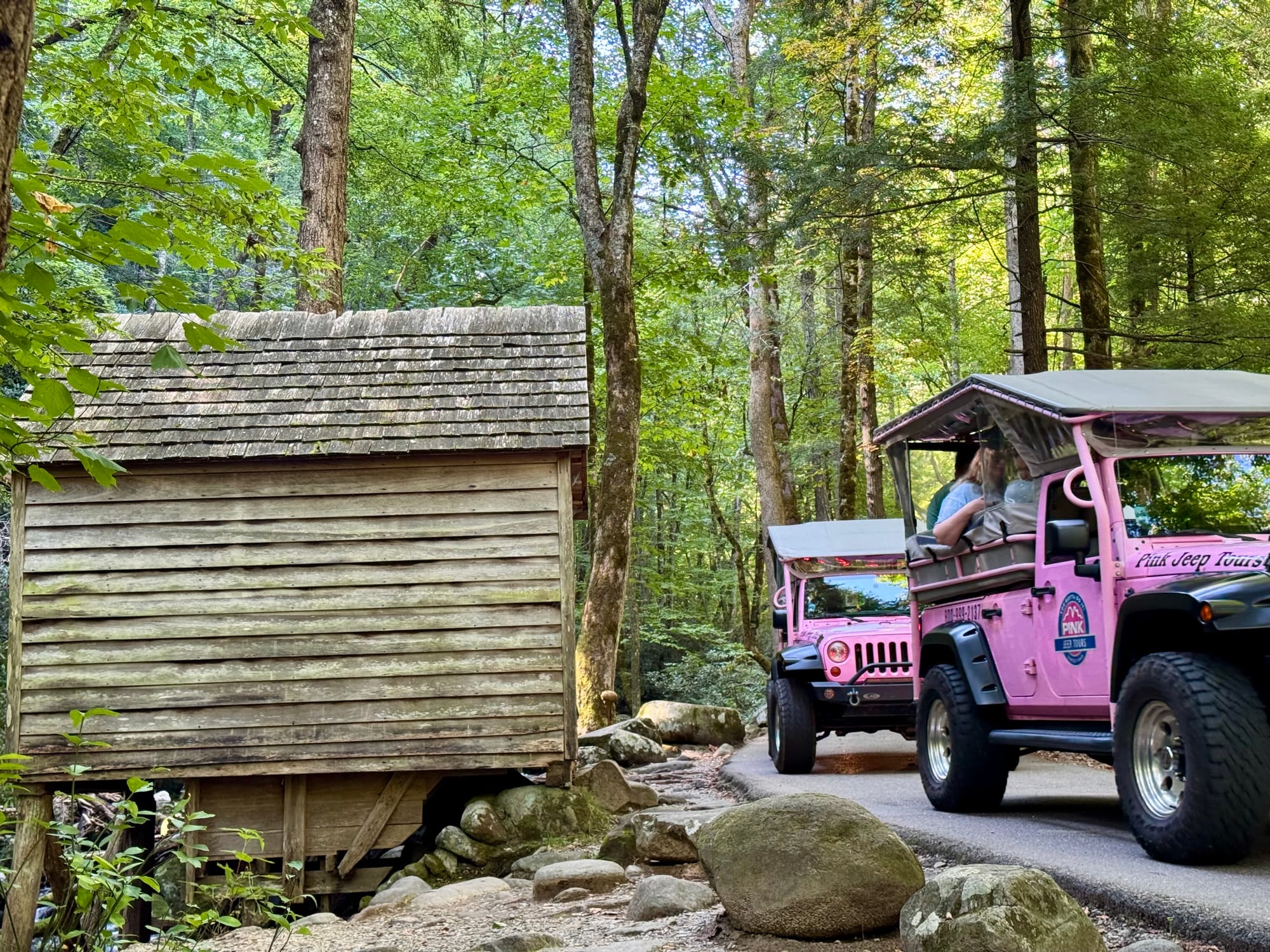
Mostly, I saw private tour guides in safari-style Jeeps double-parked at trailheads. I saw moms spraying their families down with bug spray and dads carrying little kids along the side of the road, walking from their parking spots to the trails. Those were the lucky few who’d found places to park. Most of us were destined to enjoy the forest from our cars.
According to a leaked July 2025 internal Park Service document, Great Smoky Mountains National Park had trouble opening several campgrounds and picnic areas due to the staffing cuts.
Sugarlands Visitor Center, the main entrance to the park near Gatlinburg, was an absolute zoo of people and cars. None of this was out of the ordinary—these locations are always crowded, especially on a holiday weekend. What was new, though, were all the cars parked illegally.
According to Patricia Kersey, a lead guide at the outfitter A Walk In The Woods, which offers guided backpacking trips and shuttles within the park, traffic was the most noticeable difference. “Parking at the visitor center has been a nightmare, with people just parking on the grass and blocking other cars. I haven’t seen much of a ranger presence dealing with that sort of thing, and traffic in general has been unusually heavy. It’s tough to run shuttles and get through the park.”
Part of that traffic was the result of the closure of Newfound Gap Road, the two-lane highway that runs through the center of the park between Gatlinburg and Cherokee, which was hit by a landslide in August and reopened after my visit. (This was after Hurricane Helene forced the closures of two main roads on the North Carolina side of the park.) But Kersey says the traffic was a nightmare long before that: “If you don’t get to the trailhead by 7 a.m., you’re not going to get a parking spot.”
There was a crowd gathered inside Sugarlands Visitor Center, forming lines to ask questions at the main desk, where a handful of volunteers and one park ranger were patiently answering the same questions over and over: where to find the best waterfall, the perfect spot to see a bear or elk.
I’d seen that same ranger standing in front of the visitor center an hour before it opened, answering questions from a group of tourists. Throughout my trip, I saw a handful of others: a law enforcement ranger cruising Kuwohi Road in a truck, a ranger holding elk antlers and answering questions in a parking lot, another checking me in at Elkmont Campground. Guided hikes and naturalist programs were staffed and scheduled, and I never saw trash piling up. In other words, it felt like business as usual.
That’s because the Park Service is very good at doing more with less, says Soehn, who worked in Great Smoky Mountains National Park for more than 30 years before retiring and taking a role at Friends of the Smokies. “When you don’t have enough staff,” she says, “you pull the crew that is supposed to be working on something like a historic structure to other maintenance needs, like cleaning the bathrooms. You address the greatest needs of that day.”
“The repercussions of this understaffing,” she adds, “is that you have deferred maintenance to trails and buildings, but ongoing use from visitors. You’re just constantly adding to the damage and impact on the park.”
According to the National Park Service’s latest infrastructure report, GSMNP has $259 million in deferred maintenance and repairs, along with an estimated $22 million in annual routine maintenance. Friends of the Smokies was formed in 1993 to help address that resource damage by picking up the slack in the federal budget. Since then, it has raised more than $100 million for the park. According to its 2024-2025 annual report, the group contributed $4,542,433 to the park over the fiscal year, ranging from $1.25 million for the Forever Places program, which helps restore historical structures, to $157,000 to fund wildlife technicians to monitor species like elk and black bears.
The group also funds trail restoration. Soehn says the park receives just enough money from the federal government to do a basic sweep of the park’s 850-mile trail system to clear downfall. Friends of the Smokies has stepped in, restoring seven major trails so far, including the massively popular Alum Cave Trail, Chimney Tops Trail, Rainbow Falls Trail, and this year, the six-mile Bullhead Trail, which starts near Gatlinburg and leads to 6,593-foot Mount LeConte.
“Just one of these popular trails can see more visitors than most entire national parks,” Soehn says. “That’s a lot of feet going up and down.”
This year, the organization’s role has expanded to help work around the budget constraints. Instead of just providing money for park management to purchase equipment and hire staff, it has now had to purchase that equipment themselves and directly contract employees to work in the park.
All of these efforts are going a long way to maintain the visitor experience, but the long- term health of the park remains in question.
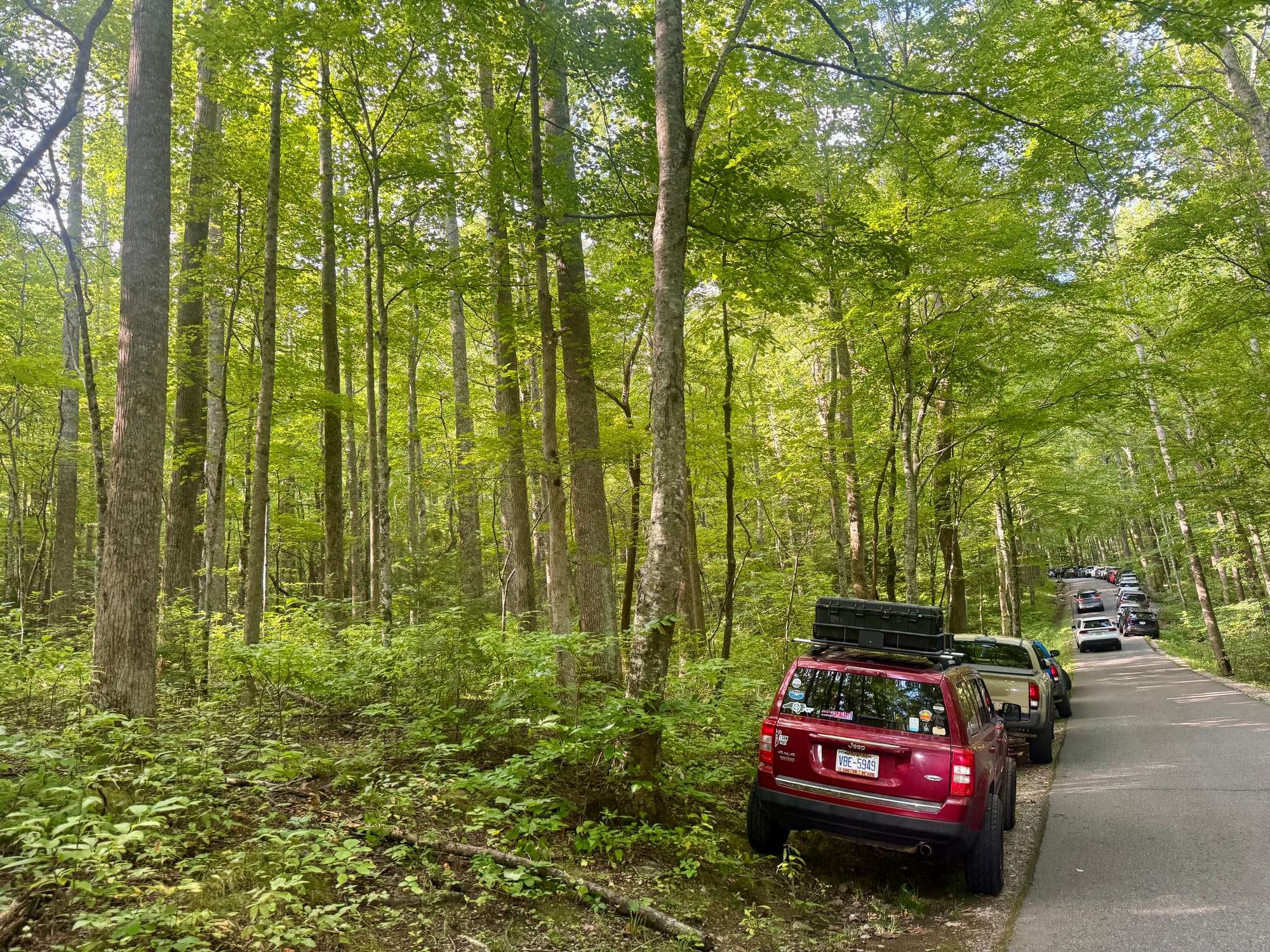
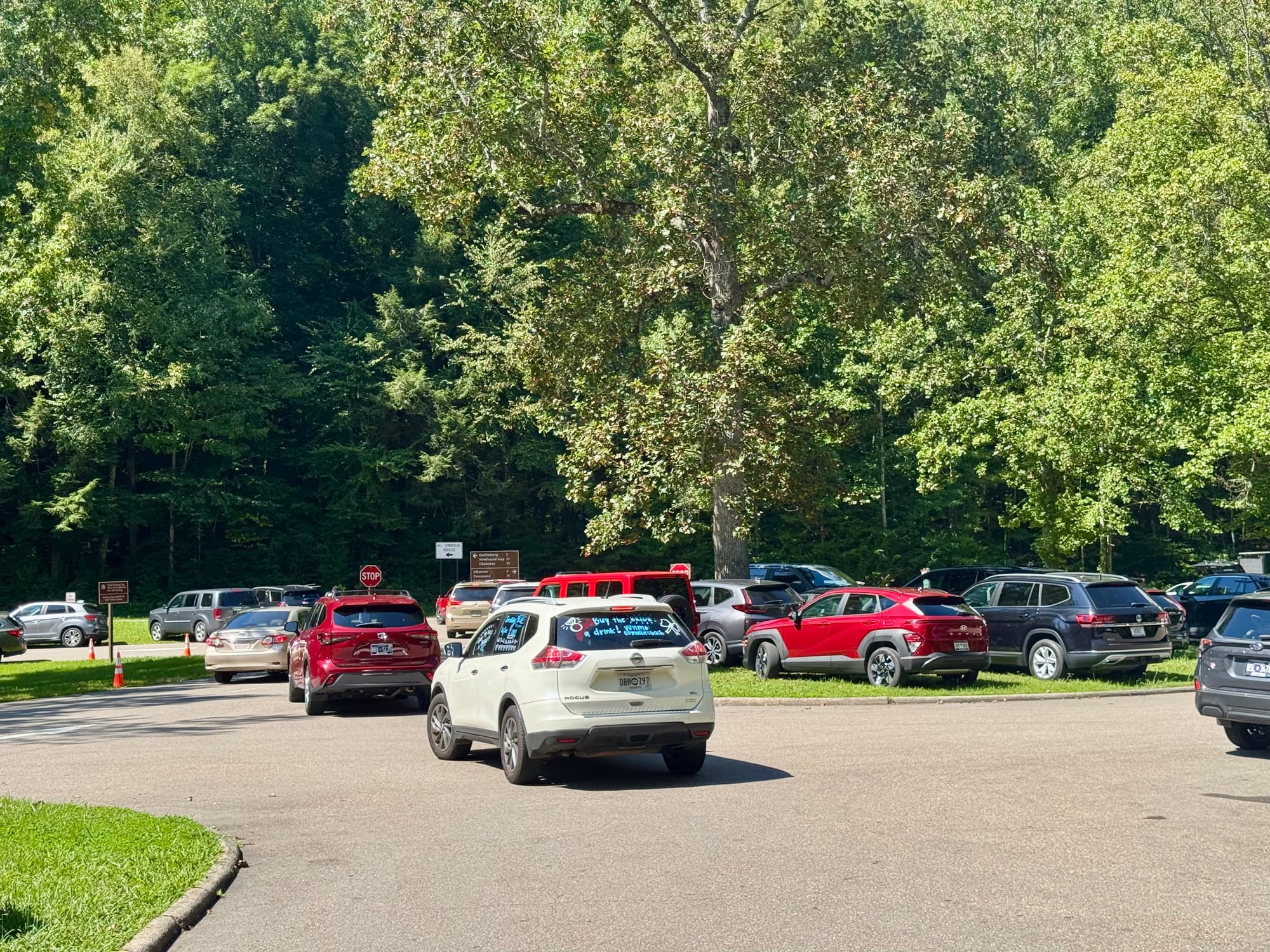
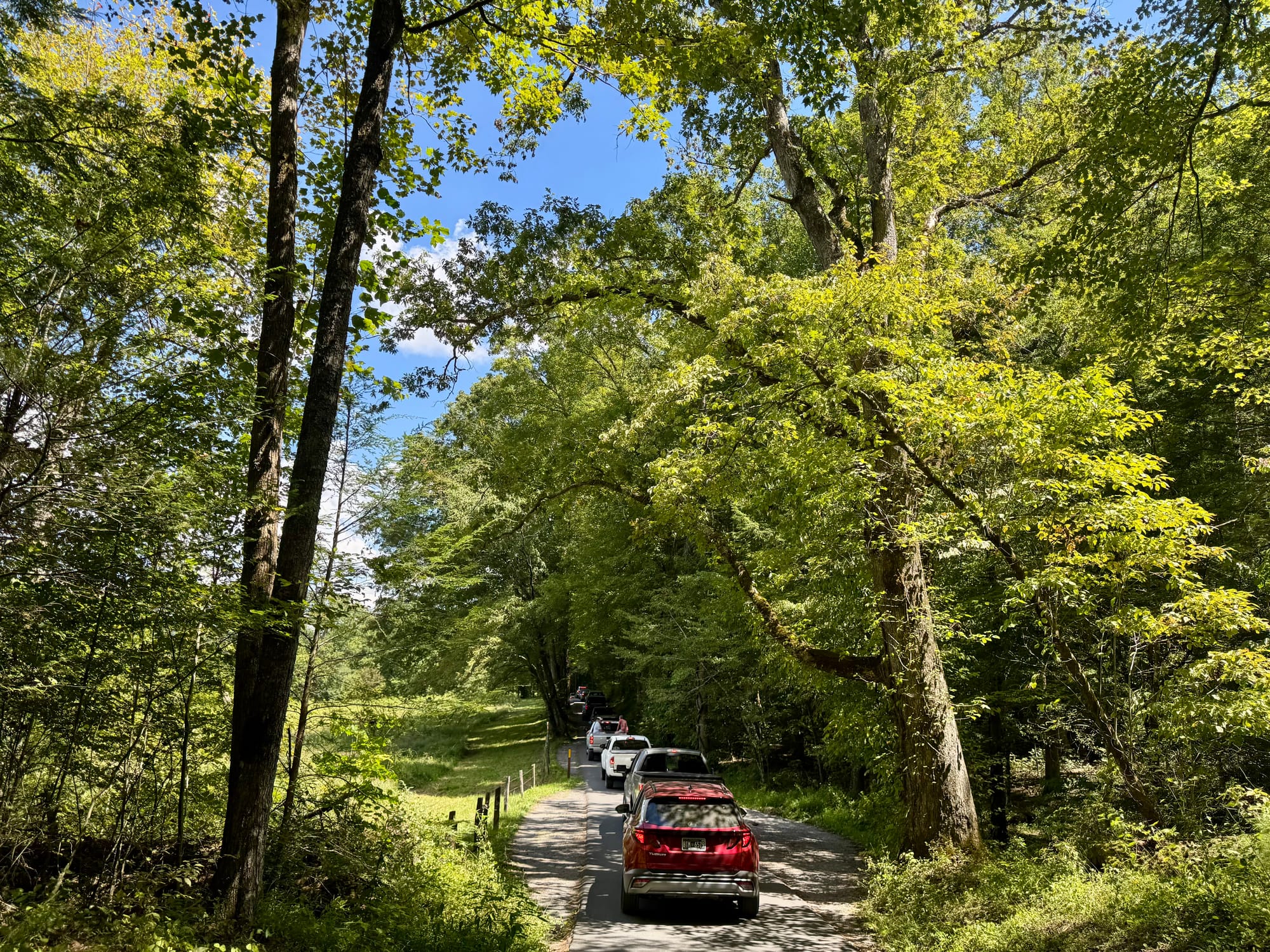
Impossible parking and lines of cars are the norm in the Great Smokies (Photo: Graham Averill)
October is typically the busiest month in the Great Smoky Mountains, when the tulip poplars turn yellow and the sugar maples blaze red. This year, the park’s planning calendar showed the month as a field of red diamonds, predicting 19 days of heavy congestion.
Instead, on October 1, the park closed Cades Cove Loop Road, Cades Cove Picnic Area, Cades Cove Visitor Center, Chimneys Picnic Area, and Sugarlands Visitor Center—some of the most heavily trafficked areas. Vesna Plakanis, owner of A Walk in the Woods guiding service, said dozens of clients immediately cancelled trips in the wake of the shutdown. But a coalition of state and local governments, as well as the Friends of the Smokies and the nonprofit Smokies Life, contributed an initial $45,000 to $80,000 each to keep the park open on a short-term basis.
“There’s no money coming from the federal government, and there’s nobody at the park service who can answer questions,” Plakanis says. “What’s happening now is a stopgap. It’s not permanent, so there’s a lot of uncertainty right now.”
By October 4, the park was fully operational, including its visitor centers and some of its campgrounds. The coalition agreed to fund the park through November 2, at which time they’ll re-address the situation if necessary. A Walk in the Woods and other outfitters are currently able to run trips, although Plakanis feels like the state of the park is in limbo.
“There’s no money coming from the federal government, and there’s nobody at the park service who can answer questions,” Plakanis says. “What’s happening now is a stopgap. It’s not permanent, so there’s a lot of uncertainty right now.”
Organizations like Friends of the Smokies stand ready to help in any way they can, and the park service employees who remain are dedicated to doing the best job they can. The question is how long they can keep it up given the circumstances.
“This is truly the dismantling of the parks,” says Kristen Brengel of the NPCA. “People don’t realize how much work goes into managing these parks, from wildlife management to trail maintenance to historical preservation.”
“The amount of repair we’re going to have to do after this administration leaves,” she says, “is going to be great, just to get the park service back to where it was. We have to get through the next three years. I hope there’s enough park service left to fix it.”

